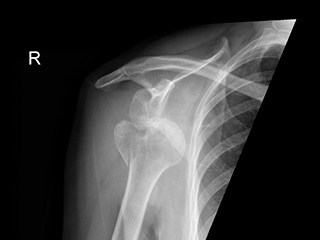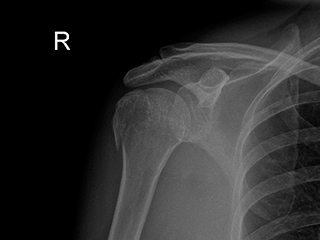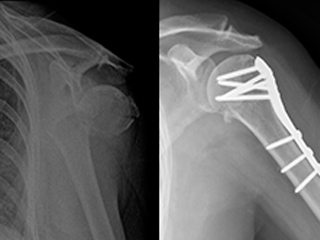Proximal humerus fractures occur in any person of any age but it is one of the most common fracture pattern in elderly. Humerus fracture has an incidence rate of 5%, and 50% of them occur in older patients aged 60 years and over. High energy trauma can cause these fractures in young people.
It can be classified by stability and fracture fragment displacement (based on Neer classification):
- Type 1 by Neer: There is no segment displaced more than 1 cm. or is rotated more than 45 degrees. These fractures are stable and their management is almost always conservative by means of tapings or slings.
- Type 2 by Neer: It is a two-part fracture without tuberosity displacement but the shaft does separate from the head and both attached tuberosities. It exists risk of necrosis because of vascular lesions. This fracture can be treated in a conservative or surgical way depending on the fragments displacement.
- Type 3 by Neer: It is a three-part fracture with the segment displaced more than 1 cm. and rotated more than 45 degrees. These fractures affect the tuberosities, one of them is separated from the head whereas the other remains attached. They are usually a reason for surgery and the treatment options for reduction and internal fixation involve open techniques.
- Type 4 by Neer: It is a complex and four-part fracture. The head is completely dislocated out he glenoid and separated from the other segments. It involves high risk of head vascular necrosis and in case the fragment reconstruction cannot be made correctly a shoulder prosthesis is considered.
Patients usually go to Emergency and present a painful and swollen arm with trouble moving which can entail a haematoma on dorsal and distal side of the humerus (hennequin haematoma). It is important to dismiss any kind of vascular or neurological injury and in order to establish diagnostic certainty it is necessary to perform specific tests such as X-ray,CT(X-ray computed tomography), etc.
Treatments depends on multiple factors such as age, type of fracture, bone quality, patient comorbidity.
A guided protocol of humerus fracture recommends an early recovery because prolonged immobilization leads to joint stiffness. An intense rehabilitation is required due to the proneness to loss of mobility. Bony union will occur between 6-8 weeks but pain can persist until three months after the trauma.












